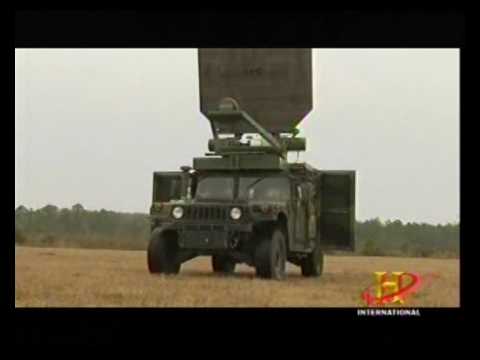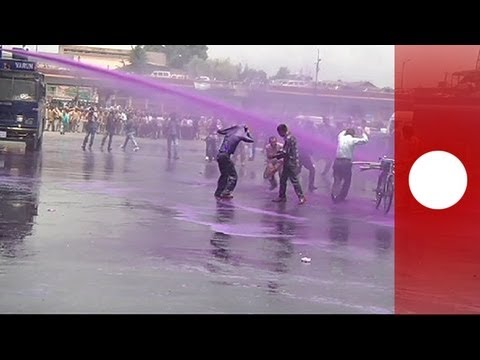10 Sonic Weapons Designed For Crowd Control
It’s well known that loud noises can cause extreme pain and hearing loss, but it wasn’t until very recently that these noises became fully weaponized. The US government has been using a powerful device for quite some time now called the Long Range Acoustic Device (LRAD). It was originally developed in order to project commands over extremely long distances, especially out at sea. LRADs were also used on the ocean to deter piracy. Its other positive uses included alerting people in the case of an emergency and even preventing wildlife from getting too close to power generators. However, as beneficial as the LRAD can be, over time it became popular as a crowd control device. A few years ago, it was turned on Occupy Wall Street protesters in order to make them disperse. More recently, it was a pivotal part of the police strategy against the Ferguson protesters. These massive devices emit incredibly loud commands, followed by noises designed to make people get as far away from the sound as quickly as they can. However, while the devices are meant for nonlethal crowd control, they are far from harmless. Not only can they cause severe headaches, they can also cause permanent hearing loss, and cities have been sued in the past for damage done by LRADs. Like many crowd control weapons, “nonlethal” almost never means “non-damaging.”
9 Laser Weapons Designed To Blind People And Potentially Sicken Them
Perhaps the least-threatening weapon being field-tested, the Dazer Laser is supposed to emit a green light that can temporarily blind a suspect without any permanent negative effects on the body. However, while it may sound fairly benign, it can supposedly make the target feel disoriented, confused, and even nauseous. Worse yet, even if you’re only blinded by the light for a short time, the purveyors of this device claim that the effects can stay with you for hours afterward. Of course, lasers are quite dangerous, especially when strong enough to be effective against humans. And since they’re pointed at the eyes, it’s hard to see how these can be entirely safe. Unfortunately, many police departments around the country are already using these dangerous devices, even though they haven’t been fully tested. Law enforcement agencies seem interested in the Dazer Laser because it’s less lethal than a Taser (as far as they currently know), and it’s also extremely easy to use.
8 An Actual Heat Ray For Dispersing Crowds
The Active Denial System sounds like something straight out of a comic book. This “sci-fi” weapon is a heat ray, and while that may seem utterly ridiculous, the truth is that the US military has been carefully developing this device for many years now. The heat ray was developed for riot control purposes, and US officials are incredibly proud of their accomplishment. Designed for military use against crowds, the heat ray could be an incredibly effective way to disperse civilian rioters in a nonlethal manner. Its inventors claim that you will not hear, see, or smell the weapon coming. Instead, you’ll feel an intense heat that causes you to feel like you are standing in front of a furnace. The military believes this will cause people to quickly disperse from an area. However, some are skeptical about the safety of such a device. A few researchers have pointed out that due to the way heat disperses, people toward the middle of a crowd could face serious injury or death. Others have speculated on the possibility that if the weapon is used on an already hot day, it might cause a crowd to become delirious or enter a full-on panic. There is also the possibility that people in the back of a crowd could make it difficult for those near the front to escape, thus causing them to burn.
7 A Taser Shotgun For When A Regular Taser Just Isn’t Enough
Tasers are one of the most controversial weapons in existence . . . and for good reason. While they are designed to be nonlethal, there are plenty of instances where Tasers have played lethal tricks on people’s nervous systems, ending their lives prematurely. For a device that is supposed to be a safer alternative to guns, this is a bit of a problem. Now, we should add that the company Taser International believes their products are generally safe, and that in the case of death, it is due to police misuse and not the fault of their device. To that end, they are concerned not so much with making Tasers safe. Instead, their primary concern is making their devices bigger and stronger. Police departments around the US have taken to this enthusiastically, and they’ve been testing and even implementing a new contraption put together by the folks at Taser. This new weapon allows them to fire a charge straight out of a shotgun. Why? Well, the original Taser is limited to a fixed range of about 8 meters (25 ft), and because the wires have to remain attached to the device, you can only effectively shock one person at a time. However, this shotgun allows you to shoot a wireless Taser charge almost 30 meters (100 ft), and then reload and shoot again very quickly. The Taser shotgun can now blast multiple people off their feet with electricity in the time it would take a normal Taser to subdue just one.
6 The Military Has Seriously Considered A Weapon For Drugging Mobs
Early in the 2000s, the Russian government used a mysterious gas in an extreme hostage situation, a scenario where many lives were at stake. Since the standoff involved a rebel group, many people questioned whether the situation was a police matter or a matter of warfare. The gas caused the death of over 100 hostages, and the Russians refuse to reveal what kind it was. They simply claim it was some form of anesthetic, a kind generally used for surgery. This led to serious controversy because, according to the Chemical Weapons Convention, weapons such as tear gas or biological agents are illegal for military use. The only exception (for some chemicals) is for police actions. And because this was a rebel group, some in the international community—especially in the United States—heavily criticized Russia for its actions. However, US leaders were being hypocritical. As some have pointed out, an organization called the Sunshine Project revealed the US had funded a university study on how to make crowd control weapons using calmative drug agents. While government officials at the time claimed no such weapons were in development, it certainly shows that they have seriously considered the possibility. To make matters more dangerous, government officials admitted to receiving unsolicited offers about such products. In other words, there are companies hungry to sell similar technologies to the government. Some are afraid this could lead to dangerous crowd control devices like weaponized Valium.
5 Water Cannons That Paint You For Future Arrest
In the United States, water cannons have a rather infamous past that causes law enforcement to shy away from them, even in favor of more brutal methods. Why? Well, during the 1960s, the most common weapons used to disperse civil rights protesters were giant water cannons (and often enormous dogs as well). However, while the US has decided to go with different methods of riot control due to its sketchy past, many other countries have no issue at all with continuing to use such crude devices in order to keep people under control. While it may not seem like the most advanced way to break up an unruly mob, the technique has actually received a few updates over the decades. Modern water cannons often have a feature where the weapon is attached to a tank full of a hard-to-remove dye. This device can be turned on and off at will. So not only can authorities douse the protesters, but they can also paint them to be identified and arrested later. This technique has been used in recent protests in India, although it’s not without controversy. Some people claim the dye used is toxic and can lead to cancer, and many say the spray often hits innocent people who aren’t even part of the protest in the first place.
4 Biological Weapons Have Been Tested On A Massive Scale Against US Citizens
When many people think of the US government, they remember its track record of doing morally reprehensible things to other countries. However, most people think American officials would stop short at doing terrible things to their own people. But the truth is that the US government has performed potentially dangerous biological weapons tests on its own citizens, without any intention of ever telling them about it. The first known tests were conducted near San Francisco in the 1950s, and they were meant to see how well biological agents could be dispersed in fog. At this time, the government only released two kinds of bacteria they believed to be fairly harmless, but the success of this test spurred them on to “greater” heights. Over the next couple decades (before the projects were finally exposed and presumably stopped), they performed 239 tests of biological agents against their own people. Many of these tests took place in major population centers, like the New York subway system, for maximum effect. Critics have pointed out that these tests broke many rules of warfare, making the US extremely hypocritical. As far as we know, the US government is no longer testing these agents on their own people.
3 Israel Uses “Skunk” Gun In Attempts To Disperse Palestinian Protesters
While some police forces and armies like to use pain, physical discomfort, or similar assaults on the senses, the Israelis decided to try something a bit more original. During the tense standoffs that often ensue due to the controversial situation in the West Bank, the Israeli military has taken to fending off Palestinian protesters by using gigantic water cannons with a much different function than you would expect. Normally, water cannons are used to hit protesters directly, driving them away with the painful force of the water. In this case though, the water is filled with an awful-smelling liquid, which is sprayed over the heads of the protesters for maximum effect and area coverage. This sludge has been described as smelling like a combination of rotting food and dead bodies. It’s a scent that won’t go away for days, even with all the shampoo and perfume in the world. Despite its nonlethal nature, some human rights groups have decided this tactic is going too far. Nevertheless, it’s incredibly effective. Some victims have said that no one would come near them for days after being hit by the sludge. But when interviewed, young Palestinian protesters claimed that it didn’t deter them from continuing their activities.
2 Pepper Spray Drones For Dispersing Unruly Crowds
As technologically advanced weapons cause warfare to become increasingly digital and less personal, instances of lining up on the battlefield are extremely rare. Many engagements are performed without getting close to the enemy. This is a perfectly logical progression of warfare. After all, the most valuable resources are your troops, and fighting remotely will always leave them in a safer position. Thus, drones are an incredibly valuable asset. The country of India has a very large population, and many of its citizens live in very cramped quarters. This makes policing difficult, especially when riots occur. This is why officials have been experimenting with flying drones rigged with cameras and pepper spray canisters, weapons that can be used remotely to disperse crowds without undue risk to the operator. While they’ve only used pepper spray so far, we can safely assume they’ll soon experiment with other possible crowd control devices. And as with any new technology that expertly performs its devious purpose, the whole world will likely catch on in no time.
1 US Military Working On An Anti-Vehicle Sticky Foam Gun
Back in the 1990s, during a Marine deployment in Somalia, the US government decided that now was the time to test one of their new weapons. It was not designed to kill the enemy. Instead, it was created to slow them down. The device fired a projectile sticky foam, and while the Marines used it during their retreat in Somalia, reports of its effectiveness were overall rather poor. The troops complained that they had been trained to spray the foam at someone’s feet in an attempt to arrest their movement. However, in reality, people could often move before the foam solidified. (Interestingly, some Marines did claim limited success in firing at people’s thighs.) Despite this initial failure, the military recently started funding a company to work on an anti-vehicle version of a foam-based sticky weapon. The idea is to shoot projectiles at the vehicle that would then release their foam payload, thus clogging the engine and causing it to stall. This would also trap the driver of the vehicle, and if the momentum was arrested properly, the weapon would leave everything in a neat package. However, it remains to be seen whether they will have better luck stopping cars with foam than they did stopping people.
























